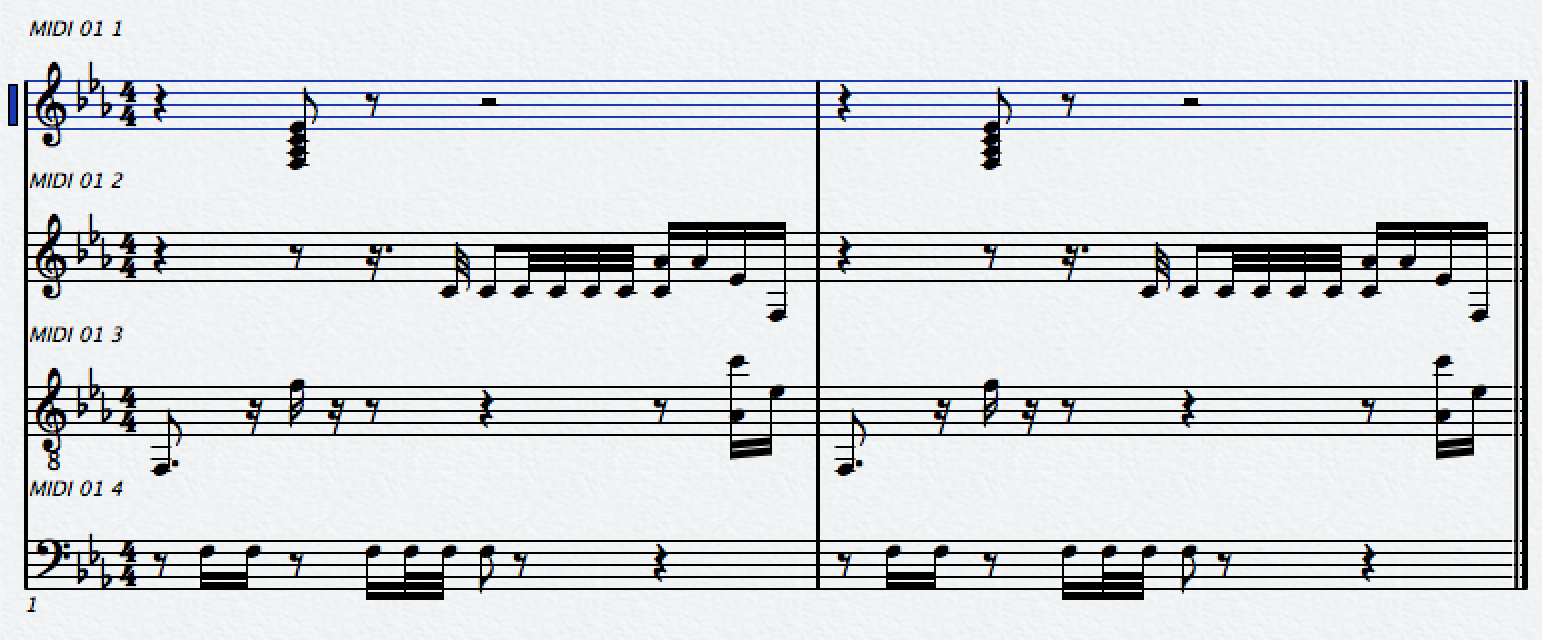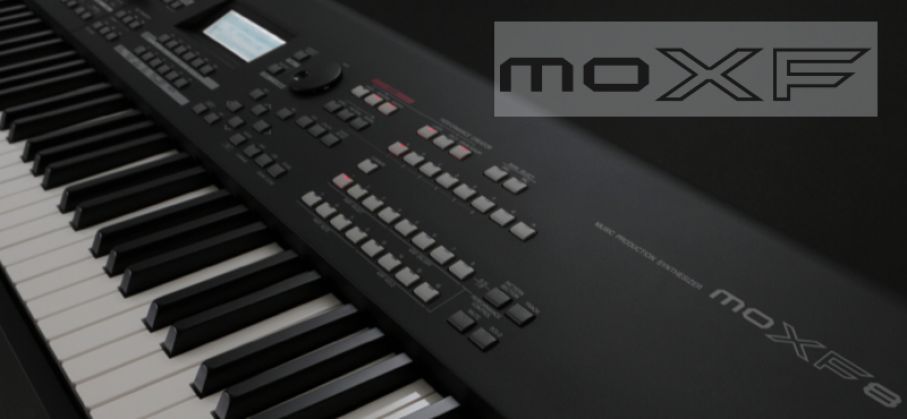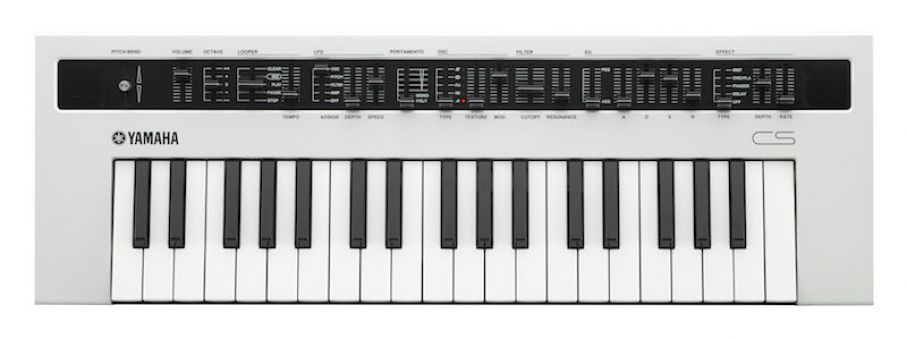The 4-Track MOXF Arpeggiator
The 4-Track Arpeggiator
User Arpeggios can be made from 4 SEQUENCER Tracks – this is often a misunderstood statement. We will shed some light on the nature of this and discuss how some of the arpeggios are made. We receive many questions on creating your own Arpeggio patterns. Basically, data from the sequencer can be converted into Arpeggio Phrases. You can convert data either from SONG or PATTERN mode using the TRACK JOB: “Put Track to Arpeggio”. In the previous articles on the Arpeggiators we established the basic rules of 16 unique notes can be used to create the data.
There are four Tracks that can be converted to create a single arpeggio phrase. Please do not misunderstand the role of these four Tracks. The four Tracks go to build a single Arpeggio Phrase that will, typically, be played by a single synthesizer instrument VOICE. In this article we will take a look at how the four Tracks of the “PUT TRACK TO ARPEGGIO” Job work to create a musical phrase with more than just average complexity. We will do so by analyzing how one of the Arpeggio Phrases that utilizes the four tracks was put together.
Each of the four tracks can provide a different rhythm (counter-rhythm) or it can be responsible for an entirely different musical line. The four Tracks can be used to trigger different behaviors in a Voice – you can precisely create NOTE-ON events that are either KEY RANGE limited to a specific region of the keyboard or they can be VELOCITY RANGE limited to cause just a specific Element to respond.
Let’s take a close look at an arp that clearly uses the four Tracks of the PUT TRACK TO ARPEGGIO Job; Recall the VOICE: “Chill Comp 2” Pre 6:122(H10)
Recall the VOICE: “Chill Comp 2” Pre 6:122(H10)
Trigger an Fminor7 chord in root position starting with the “F” below middle “C”. The resulting arpeggio phrase can be seen in the notation below broken down by the four ‘sequencer’ tracks that created it.

Press [F5] ARP ED (Arpeggio Edit)
Pres [SF3] MAIN
If you prefer you can set the HOLD function to ON, this will latch the arpeggio phrase so that you do not have to continue to hold down the keys.
An alternate method would be to latch the arpeggio phrase with the Sustain pedal. The Sustain pedal takes the place of you holding down the keys… it does not sustain the sound (as on an acoustic piano), this is a synthesizer, remember. HOLD is technically, the keys being in KEY ON mode. The Sustain pedal keeps the KEY ON mode active. We mention this because it is a frequently asked question; as to why the sound does not sustain when an arpeggio is playing. It’s because it is the arpeggiator phrase that is “playing” the Voice, not you. You are providing the trigger notes, so when you step on the Sustain pedal it is you extending the trigger notes. If you want the sound of the arpeggiated VOICE to sustain you would need to place the Sustain pedal controller message (cc064) in the actual arpeggio data. Make sense?
ChillComp2
There is some artful fun going on with quarter notes and the “Tempo Cross Delay” INSERTION EFFECT, but that will have to be the subject of another article. If you wish to hear just what was played and transferred from the SEQUENCER for this Arpeggio Phrase, you will want to turn OFF the [INSERTION EFFECT]. You can do so with a dedicated front panel button.
It is actually a one-measure Phrase. I printed out two measures just for ease of reading. This notation shown in this article was done with Cubase AI’s built-in SCORE function (by the way).
 The KEY MODE of this VOICE is set to “sort” and the VELOCITY MODE = “original”.
The KEY MODE of this VOICE is set to “sort” and the VELOCITY MODE = “original”.
Translation: What you are hearing is triggered by the arpeggiator phrase data, and the velocity is determined by that phrase data. So it matters not how strongly you trigger the notes, it is the arpeggiator that is “playing” the Voice. It is important to know when you are directly triggering the sound of the Voice and when you are triggering the arpeggiator, which in turn is triggering the Voice
The Element that sounds is pre-determined by the arpeggio phrase.
Press ARP ED
Press [F3] MAIN (shown)
Press [EDIT]
Press [1] to view Element 1 Edit parameters
You can see that [9], [10], [11] and [12] indicate that this is a four Element Voice.
Use the [MUTE] function to turn off Elements and isolate each one in turn.
Element 1
Element 1 is an electric piano Waveform that plays the chord on the 2nd beat. This is the actual chord voicing used to trigger this result. Fminor7 voiced in root position including middle “C”. You trigger the chord but Element 1 does not respond until the arpeggio phrase triggers this Element on the second quarter note (according to the current TEMPO setting).
EL1: is responding to velocities: 1-70
Element 2
Element 2 is a P5 (Prophet V) Waveform that plays a muted, plucky analog staccato phrase. The 32nd notes make this line stand out.
EL2: is responding to velocities: 71-90
Element 3
Element 3 is a second (different) electric piano Waveform playing a counter line. This is the only note that plays on the first downbeat. Even though you may press four notes, only one note responds initially – that one note is generated by Element 3 because the arpeggio phrase’s note velocity is in the range 91-110.
Element 4
Element 4 is a synth bass Waveform acting as the bass line (note the Bass Clef). Velocity 111-127



 Shown are the VEL LIMIT LOW and VEL LIMIT HIGH settings for each of the first four Elements this is how this Voice is Zoned for Velocity response from notes-on events sent in by the assigned arpeggiator.
Shown are the VEL LIMIT LOW and VEL LIMIT HIGH settings for each of the first four Elements this is how this Voice is Zoned for Velocity response from notes-on events sent in by the assigned arpeggiator.
Put Track To Arp:
To understand how this ARP was made you must imagine the four phrases recorded to the first four tracks of the MOXF sequencer.
Record the above four lines each to a separate Track of the MOXF sequencer – each assigned to the “Chill Comp 2” Voice.
Record measure of each line as shown above, to tracks 1, 2, 3 and 4 of the PATTERN mode sequencer.
Set the “Put Track To Arp” Job as shown below… Notice that “ArpTrack 1, 2, 3 and 4 are shown




Section A
Measure 001–001 is the equivalent of one complete measures.
Target User Arp 001 – Chill
Main Category – Hybrid
SubCategory – Zone
The “Original Notes” Convert Type with the “Original Note Root” = F2 was selected to create a chord intelligent arpeggio phrase, that will sound properly when F2 is the lowest note. This will create the ARP PHRASE you hear for ARP TYPE #7676

